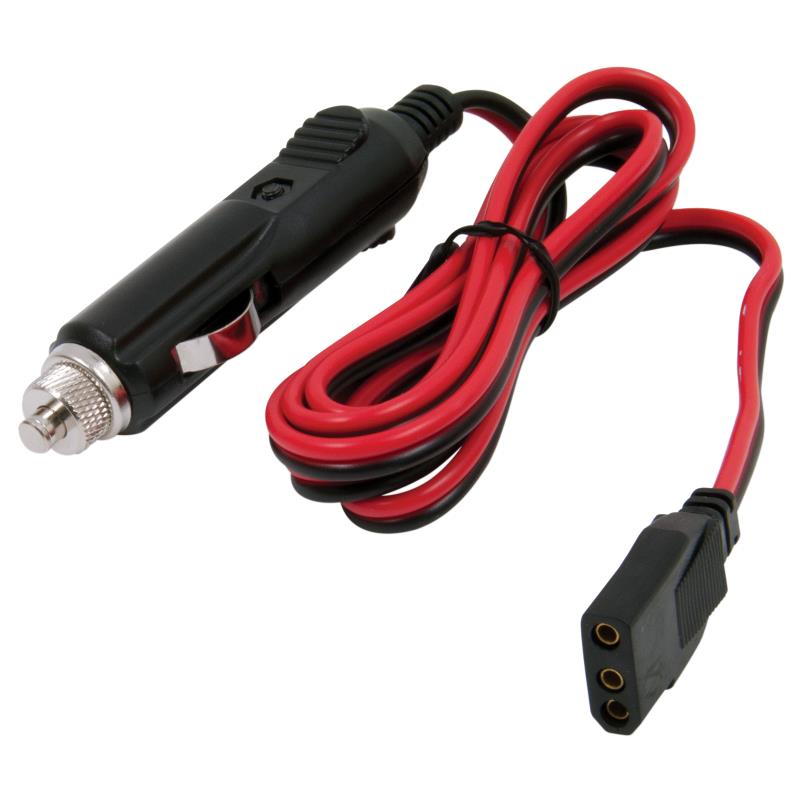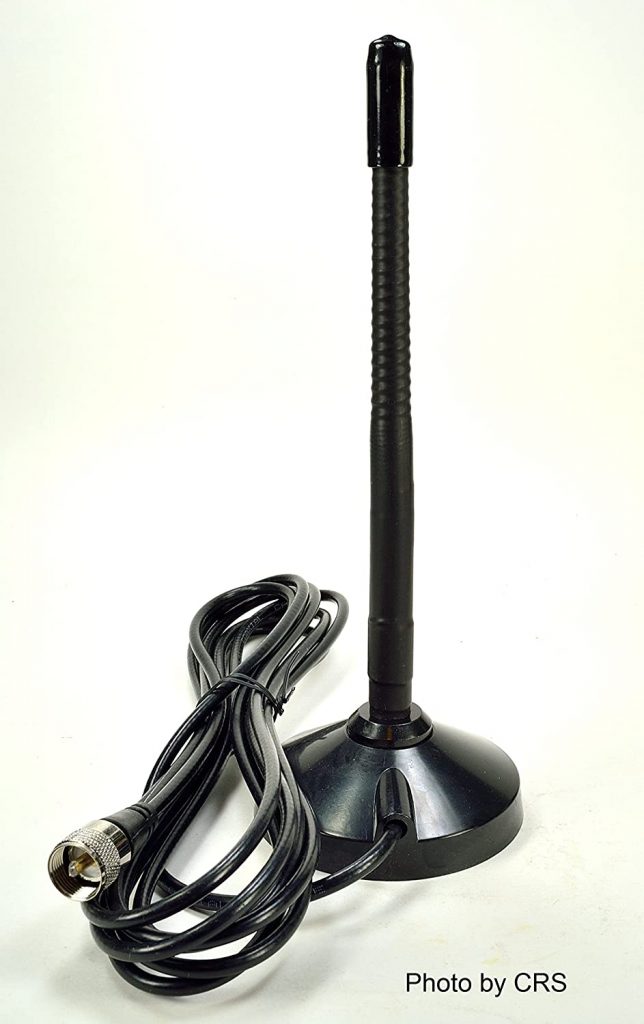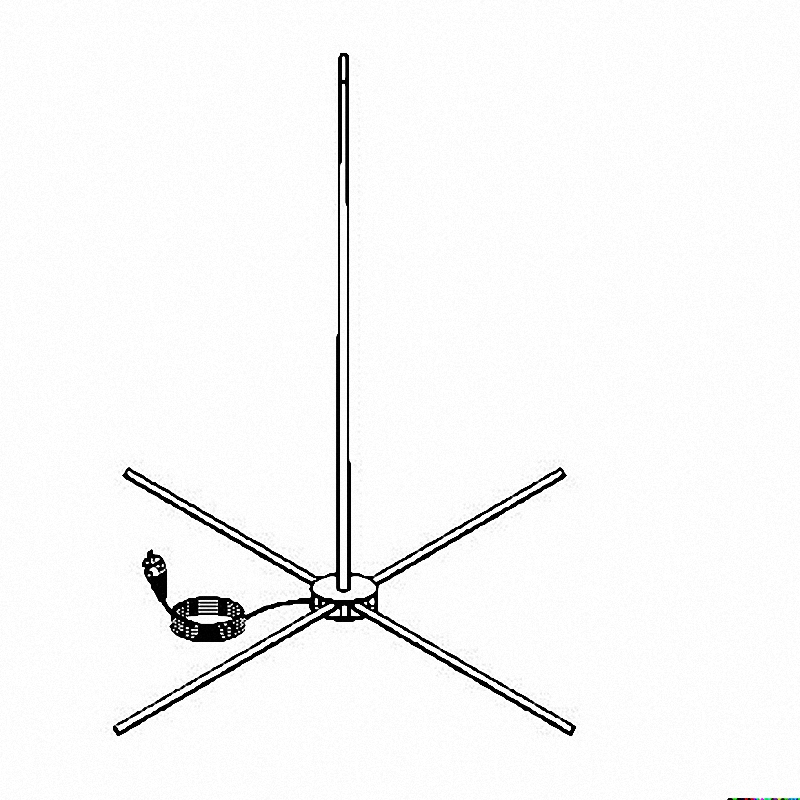This page will give you info and recommendations on what you need to purchase to get on the air ASAP. After you have purchased equipment, or if you already have equipment, check out our getting started page to see how to set everything up.
What to Purchase
The quickest and easiest way to get on the air is to buy a handheld CB radio (see our recommendations below), however, a mobile (vehicle) set up or a home “base station” set up is usually more practical for communicating long distances. Handheld CB radios — if you use the flexible rubber antenna (rubber duck antenna) provided with the radio — will usually only broadcast a couple blocks in a city, and maybe a mile or two in flat open country. Range is highly variable, but generally speaking, a good mobile set up in a vehicle will usually transmit 1 to 5 miles, and a good base station set up can typically transmit 2 to 10 miles — and potentially hundreds of miles during skip (skip = when atmospheric conditions are conducive to long distance communication).
We recommend buying a CB with these features:
- 40 channels with channel scan (channel scan allows the radio to quickly search for signals on all channels — rather than you having to flip through all the channels manually)
- NOAA weather bands (this feature will allow you to get weather updates and severe weather alerts with the touch of a button)
- Built in SWR meter (this allows you to make sure your antenna is tuned properly so that, most importantly, you are not damaging your radio, and so that you can talk long distances)
You can purchase cheaper models without these features, however, in our experience these features are essential to being able to get the most out of using a CB radio.
Our favorite handheld/mobile set up:
- Midland 75-822 — this model can be used as a handheld or set up in your vehicle to use with a cigarette lighter electric outlet and an external antenna. It can pick up the NOAA weather bands and it has channel scan feature. Unfortunately this model does not have a built in SWR meter, so you will have to purchase one if you want to use it as a mobile set up in a vehicle (Astatic makes great, affordable SWR meters, and mics too).
Our favorites for mobile set/base station up:
- Uniden 980 SSB
- President McKinley
Unless you plan on using a simple handheld with the included flexible rubber antenna (rubber duck antenna) that comes with it you will need to buy an antenna and some coaxial cable (coax) with your CB radio (see the section on antennas and coax below). Additionally, you will need a way to power your CB radio. The simplest set up for power (besides using a handheld CB with the supplied antenna — which limits your range to a couple blocks in the city and isn’t practical for most purposes) is a mobile set up in your vehicle. For a very easy mobile set up you will simply power the CB radio via your cars cigarette lighter electrical outlet. To do this you will want to buy a 12 volt 3-pin cigarette lighter plug fused cord. Simply plug the 3 pin connector into the back of your CB radio, hook up / tune your antenna and you are ready to go!

12 volt 3-pin cigarette lighter plug fused cord
With a home or “base station” set up you will need to buy an AC power supply. The following product is highly recommended: Pyramid PS9KX Universal Compact Bench Power Supply-5 Amp Linear Regulated Converter w/ 13.8 Volt DC 115V AC 70 Watt Input, Screw Type Terminal, 12V Car Cigarette Lighter.

Pyramid PS9KX
With this power supply you can either use a 12 volt 3-pin cigarette lighter plug fused cord, or a bare stranded 12 volt 3-pin fused cord (the bare parts of the wire will screw onto the corresponding red and black terminals on the power supply — red [or positive] to red, black [or negative] to black).

Bare stranded 12 volt 3-pin fused cord
Antennas and Coax
For a mobile CB set up you will use RG-58 (aka RG-58/U if it meets Universal specifications) coaxial cable (coax) with PL-259 connectors. CB coax is typically male to male. One end of the coax will plug into your antenna input on the back of your radio — to the female UHF or SO-239 connector — and the other end will screw onto your antenna. Make sure you measure how much coax you will need to get to your antenna so that you buy the appropriate length. Mobile (vehicle) antenna kits often come with 15 feet of coax, which is usually sufficient for this type of set up.

RG-58 coax with PL-259 connectors
(Note: There is always some signal loss with coax; this signal loss increases with the length of the coax. If you are running more than 100 feet you will want to consider using a bigger gauge coax, such as RG-8, RG-8X, RG-213, or, ideally, LMR-400 [also called KMR-400] coax in order to reduce signal loss. These types of coax will be quite a bit thicker, and therefore somewhat more difficult to work with. For a mobile set up you will probably want to stay away from thicker coax.)
Again, the mobile set up is easiest as you can buy a magnet mount antenna that has coax already attached to it. Firestik and Wilson make great magnet mount antennas. There is also the option to hardwire a mounted mobile antenna; for these more complicated installations we recommend rightchannelradios.com
One word of caution: stay away from through-the-glass window mount antennas, as they tend to have very high SWRs and do not allow your signal to go very far. The smallest, least noticeable antenna you can realistically use would be something like this 10 inch rubber duck CB magnet mount antenna:

To get maximum transmission range you will need something like this 37.5 inch whip antenna (only the base and part of the whip is in the pic):

Base stations antennas
A home CB set-up is called a “base station”. For a base station you will likely use longer lengths of coax, so you will need something with less line loss (signal strength lost through the cable) than the type of really flexible coax used for mobile set-ups. For a base station, then, you will want to run low-loss coax like RG-8, RG-8X, RG-213, or, ideally, LMR-400 (also called KMR-400). CB coax uses UHF connectors — aka PL-259 connectors; female UHF connectors (such as the one on the back of your radio) are also called SO-239 connectors. One end of the coax will plug into your antenna input on the back of your radio, and the other end will screw onto your antenna. (For more information on set-up see: https://easycbradio.com/getting-started/setting-up/)
Traditonal base station antennas for CB are often quite long (tall) — usually around 20 feet. Installing an antenna this long is somewhat difficult and sometimes guy-wires (cable supports) are required. Because of this we recommend the Workman Saturn B-100, also sold as Tram CB base antenna, or the Firestik 5′ Indoor CB Base Antenna IBA5 — these are short (3 – 5 feet) antennas that can be mounted virtually anywhere (e.g., on apartment balcony, strapped to a vent pipe on a roof, in an attic, etc.). These small antennas will limit your range (compared to a 20 foot antenna), but you should still be able to get your signal out several miles. We have used a Saturn B100 to talk to CBers 10 or more miles away.

Firestik 5′ Indoor CB Base Antenna IBA5

Workman Saturn B-100
Another option for a base station set up, that won’t limit your range as much, is a dipole—which is essentially a length of insulated wire. One option is the Falcon 2400 watt 11 meter dipole. This antenna can be strung up anywhere that is convenient, such as in trees or in an attic.

Falcon 2400 watt 11 meter dipole
All outdoor antennas on or near a home will need to be grounded to protect against lightning strikes. This is done by driving a copper-clad grounding rod or pipe into the ground (preferably 8 feet) and connecting the antenna to it via grounding clamps and #10 AWG (American Wire Gauge) copper wire. Also, make sure that with any antenna you buy that it is approved for use on 11 meter bands (the CB radio band is referred to as the 11 meter band because it produces an 11 meter wavelength).
